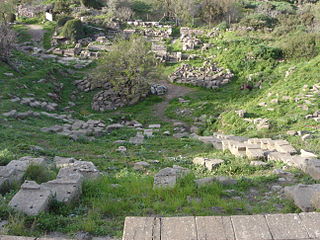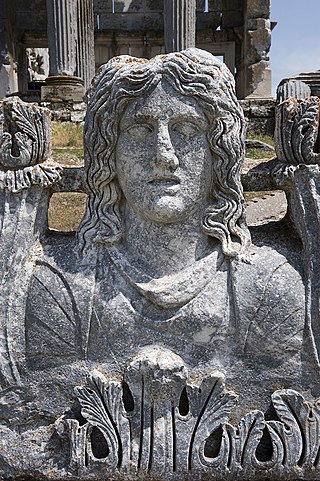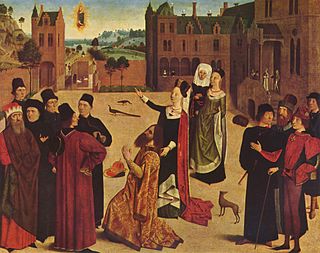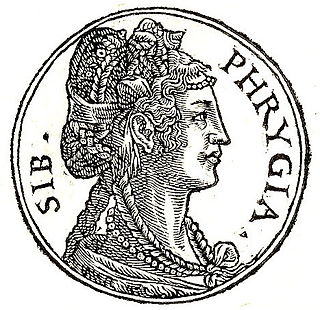
An oracle is a person or thing considered to provide insight, wise counsel or prophetic predictions, most notably including precognition of the future, inspired by deities. If done through occultic means, it is a form of divination.

Pythia was the title of the high priestess of the Temple of Apollo at Delphi. She specifically served as its oracle and was known as the Oracle of Delphi. Her title was also historically glossed in English as the Pythoness.

In religion, a prophecy is a message that has been communicated to a person by a supernatural entity. Prophecies are a feature of many cultures and belief systems and usually contain divine will or law, or preternatural knowledge, for example of future events. They can be revealed to the prophet in various ways depending on the religion and the story, such as visions, or direct interaction with divine beings in physical form. Stories of prophetic deeds sometimes receive considerable attention and some have been known to survive for centuries through oral tradition or as religious texts.

Erythrae or Erythrai later Lythri(Λυθρί, turk. Ildırı) was one of the twelve Ionian cities of Asia Minor, situated 22 km north-east of the port of Cyssus, on a small peninsula stretching into the Bay of Erythrae, at an equal distance from the mountains Mimas and Corycus, and directly opposite the island of Chios. It is recorded that excellent wine was produced in the peninsula. Erythrae was notable for being the seat of the Erythraean Sibyl. The ruins of the city are found north of the town Ildırı in the Çeşme district of İzmir Province, Turkey.

The sibyls were prophetesses or oracles in Ancient Greece.

An acrostic is a poem or other word composition in which the first letter of each new line spells out a word, message or the alphabet. The term comes from the French acrostiche from post-classical Latin acrostichis, from Koine Greek ἀκροστιχίς, from Ancient Greek ἄκρος "highest, topmost" and στίχος "verse". As a form of constrained writing, an acrostic can be used as a mnemonic device to aid memory retrieval. When the last letter of each new line forms a word it is called a telestich; the combination of an acrostic and a telestich in the same composition is called a double acrostic.

The Sibylline Oracles are a collection of oracular utterances written in Greek hexameters ascribed to the Sibyls, prophetesses who uttered divine revelations in a frenzied state. Fourteen books and eight fragments of Sibylline Oracles survive, in an edition of the 6th or 7th century AD. They are not to be confused with the original Sibylline Books of the ancient Etruscans and Romans which were burned by order of the Roman general Flavius Stilicho in the 4th century AD. Instead, the text is an "odd pastiche" of Hellenistic and Roman mythology interspersed with Jewish, Gnostic and early Christian legend.

The Tiburtine Sibyl or Albunea was a Roman sibyl, whose seat was the ancient Etruscan town of Tibur.
The Sibylline Books were a collection of oracular utterances, set out in Greek hexameter verses, that, according to tradition, were purchased from a sibyl by the last king of Rome, Lucius Tarquinius Superbus, and consulted at momentous crises through the history of the Roman Republic and the Empire.

The Delphic Sibyl was a woman who was a prophet associated with early religious practices in Ancient Greece and is said to have been venerated from before the Trojan Wars as an important oracle. At that time Delphi was a place of worship for Gaia, the mother goddess connected with fertility rituals that are thought to have existed throughout the ancient Mediterranean world. As needed to maintain the religious tradition, the role of sibyl would pass to another priestess at each site.

The Hellespontine Sibyl was the priestess presiding over the Apollonian oracle at Dardania. The Sibyl is sometimes referred to as the Trojan Sibyl. The word Sibyl comes from the Ancient Greek word sibylla, meaning prophetess or oracle. The Hellespontine Sibyl was known, particularly in the late Roman Imperial period and the early Middle Ages, for a claim that she predicted the crucifixion of Jesus Christ. This claim comes from the Sibylline Oracles, which are not to be confused with the Sibylline Books.

The Persian Sibyl – also known as the Babylonian, Chaldaean, Hebrew or Egyptian Sibyl – was the prophetic priestess presiding over the Apollonian oracle.

The Cimmerian Sibyl, by name Carmentis, was the prophetic priestess presiding over the Apollonian Oracle at Cimmerium in Italy, near Lake Avernus.

The Samian Sibyl was the priestess presiding over the Apollonian oracle near Hera's temple on the Isle of Samos, a Greek colony. The word Sibyl comes from the ancient Greek word sibylla, meaning prophetess. There were many Sibyls in the ancient world but she is the one who prophesied the Birth of Jesus in the stable. The Samian Sibyl, by name Phemonoe, or Phyto of whom Eratosthenes wrote.

In the extended complement of sibyls of the Gothic and Renaissance imagination, the Phrygian Sibyl was the priestess presiding over an Apollonian oracle at Phrygia, a historical kingdom in the west central part of the Anatolian highlands. She was popularly identified with Cassandra, prophetess daughter of Priam's in Homer's Iliad.
Last Roman Emperor, also known as Last World Emperor or Emperor of the Last Days, is a figure of medieval European legend, which developed as an aspect of Christian eschatology. The legend predicts that in the end times, a last emperor would appear on earth to reestablish the Roman Empire and assume his function as biblical katechon who stalls the coming of the Antichrist. The legend first appears in the 7th-century apocalyptic text known as the Apocalypse of Pseudo-Methodius; that and the oracles of the Tiburtine Sibyl are its two most important sources. It developed over the centuries, becoming particularly prominent in the 15th century. The notion of Great Catholic Monarch is related to it.

The Cumaean Sibyl was the priestess presiding over the Apollonian oracle at Cumae, a Greek colony near Naples, Italy. The word sibyl comes from the ancient Greek word sibylla, meaning prophetess. There were many sibyls throughout the ancient world. Because of the importance of the Cumaean Sibyl in the legends of early Rome as codified in Virgil's Aeneid VI, and because of her proximity to Rome, the Cumaean Sibyl became the most famous among the Romans. The Erythraean Sibyl from modern-day Turkey was famed among Greeks, as was the oldest Hellenic oracle, the Sibyl of Dodona, dating to the second millennium BC according to Herodotus, favored in the east.
Marpessos was a settlement in the middle Skamander valley of the Troad region of Anatolia. The settlement's name is also spelled Μαρμησσός, Μαρμισσός, Μερμησσός in ancient sources. It was known in Classical antiquity primarily as the birthplace of the Hellespontine Sibyl Herophile. Its site has been located at Dam Dere approximately 2 km SE of the village of Zerdalilik in the Bayramiç district of Çanakkale Province in Turkey. Despite the similarity of its name and its location on Mount Ida, the settlement is apparently unrelated to the mythological figure Marpessa and her husband Idas. It should likewise not be confused with the Mount Marpessa on Paros.

Eclogue4, also known as the FourthEclogue, is a Latin poem by the Roman poet Virgil. The poem is dated to 40 BC by its mention of the consulship of Virgil's patron Gaius Asinius Pollio.

Eclogue 4, also known as the Fourth Eclogue, is the name of a Latin poem by the Roman poet Virgil. Part of his first major work, the Eclogues, the piece was written around 40 BC, during a time of brief stability following the Treaty of Brundisium; it was later published in and around the years 39–38 BC. The work describes the birth of a boy, a supposed savior, who once of age will become divine and eventually rule over the world. During late antiquity and the Middle Ages, a desire emerged to view Virgil as a virtuous pagan, and as such the early Christian theologian Lactantius, and St. Augustine—to varying degrees—reinterpreted the poem to be about the birth of Jesus Christ.


















